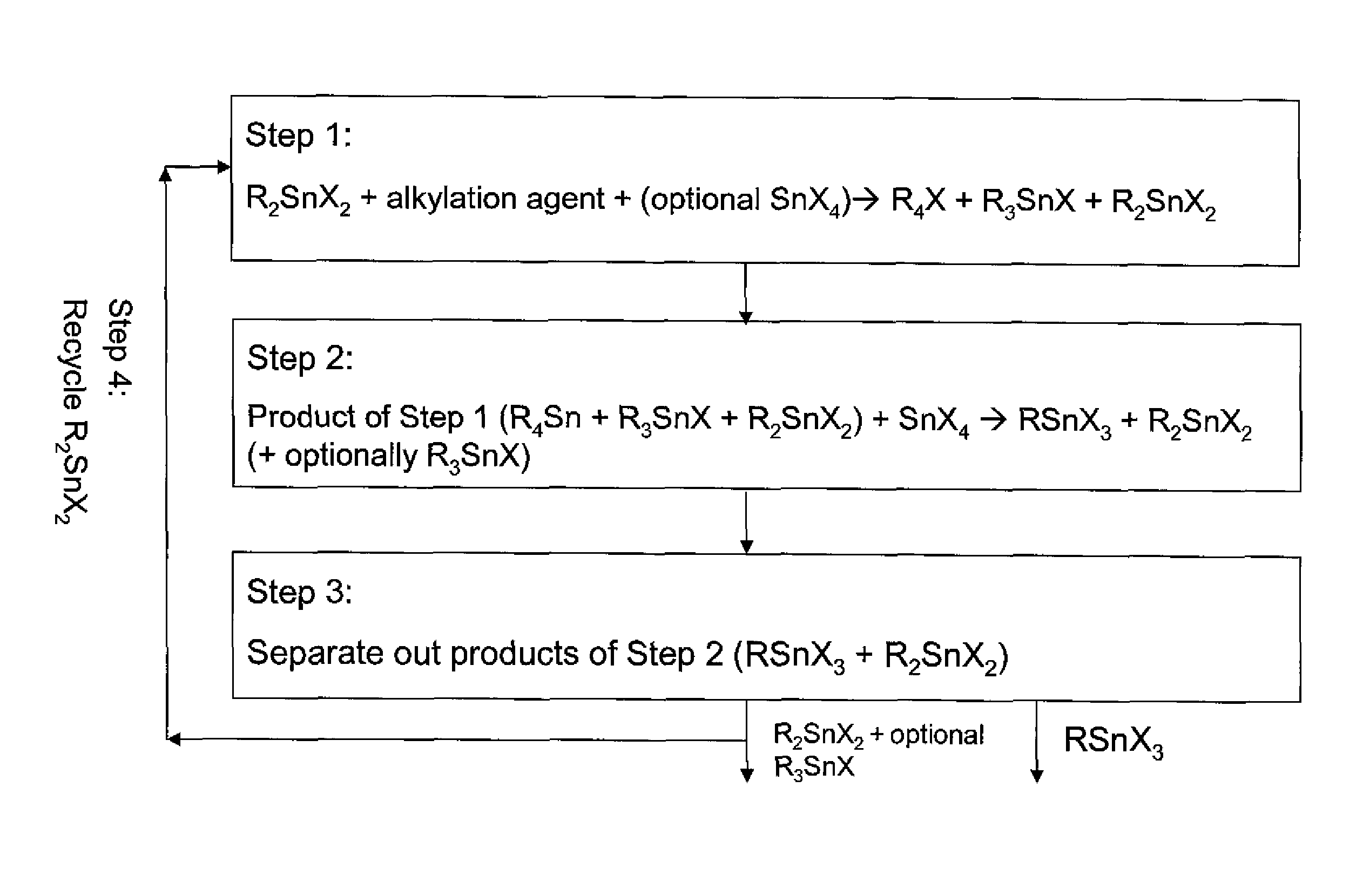Process for preparing monoalkyltin trihalides and dialkyltin dihalides
a dialkyltin dihalide and monoalkyltin technology, applied in the field of monoalkyltin trihalides or mixtures of monoalkyltin trihalides and dialkyltin dihalides, can solve the problems of increasing the toxicity of monoalkyltin compounds, toxicity of di-alkyltin compounds, and the production of monoalkyltin trihalides, etc., to achieve high purity, high yield, and high yield
- Summary
- Abstract
- Description
- Claims
- Application Information
AI Technical Summary
Benefits of technology
Problems solved by technology
Method used
Image
Examples
example 1
Monobutyltin Trichloride and Dibutyltin Dichloride Synthesis Using tri-n-Butylaluminum as the Alkylating Agent
[0062]First, dibutyl ether is charged to a reaction flask and inerted with nitrogen. Based on the amounts of dibutyltin dichloride and tin tetrachloride, the amount of tri-n-butylaluminum required to produce an 85:15 mixture of tetrabutyltin and tributyltin chloride is charged to the reaction flask and agitated to give a homogeneous mixture. Tin tetrachloride and dibutyltin dichloride are then added at a rate to keep the temperature of the reaction mixture below 70° C. After the end of addition, the mixture is agitated for 2 hours and cooled to about 20° C. Water is added in an amount to give a nearly saturated solution of aluminum trichloride, and the mixture agitated for 30 minutes. Agitation is stopped and the phases allowed to split for 1 hour. The aqueous phase is removed and the organic phase is vacuum stripped to remove residual water and the dibutyl ether solvent lea...
example 2
Monobutyltin Trichloride and Dibutyltin Dichloride Synthesis Using n-Butylmagnesium Chloride as the Alkylating Agent
[0066]First, dibutyltin dichloride, and optionally tin tetrachloride, is dissolved in heptane under a dinitrogen atmosphere. A solution of n-butyl magnesium chloride (nBuMgCl) in tetrahydrofuran (THF) (1 molar equiv. to Sn—Cl) is added under stirring at a rate to keep the temperature of the reaction mixture below 70° C. After the end of the addition, the mixture is diluted with hexane and agitated for 2 hours under reflux. Ca. 25% of the THF is distilled off atmospherically. The mixture is cooled to about 20° C. and added with stirring to a 2.4 wt % solution of hydrochloric acid (HCl) in water in an amount to give a nearly saturated solution of MgCl2. After stirring for 15 min and cooling to about 20° C., agitation is stopped and the phases are allowed to split. The aqueous phase is removed and the organic phase is vacuum stripped to remove residual water and solvents ...
example 3
Monooctyltin Trichloride and Dioctyltin Dichloride with Recycling of Dioctyltin Dichloride to Tetraoctyltin using n-Octylmagnesium Chloride as the Alkylating Agent
[0070]A 1 L three-necked flask was charged with a nOct4Sn reaction product (400 g obtained from a previous cycle, Oct4Sn, 87.8 wt %; Oct3SnCl, 2.5 wt %; Oct2SnCl2, 1.6 wt %), inerted and heated to 75° C. SnCl4 (325 g, 1.25 mol, corresponding to two equiv. on Oct4Sn and one equiv. on Oct3SnCl) was slowly added and the resulting dark suspension was heated further to 130° C. and stirred for two hours at this temperature. A sample was taken from the mixture, butylated and analyzed by gas chromatography. Part of the nOctSnCl3 was fractionally distilled from the mixture at 15-18 mbar, 157-158° C. The purity and composition of the distillate and distillation residue were determined by gas chromatographic analysis after alkylation with BuMgCl. The results are listed in Tables 3 and 4 (cycle 3).
n-Octylmagnesium ch...
PUM
| Property | Measurement | Unit |
|---|---|---|
| temperature | aaaaa | aaaaa |
| temperature | aaaaa | aaaaa |
| temperature | aaaaa | aaaaa |
Abstract
Description
Claims
Application Information
 Login to View More
Login to View More - R&D
- Intellectual Property
- Life Sciences
- Materials
- Tech Scout
- Unparalleled Data Quality
- Higher Quality Content
- 60% Fewer Hallucinations
Browse by: Latest US Patents, China's latest patents, Technical Efficacy Thesaurus, Application Domain, Technology Topic, Popular Technical Reports.
© 2025 PatSnap. All rights reserved.Legal|Privacy policy|Modern Slavery Act Transparency Statement|Sitemap|About US| Contact US: help@patsnap.com



